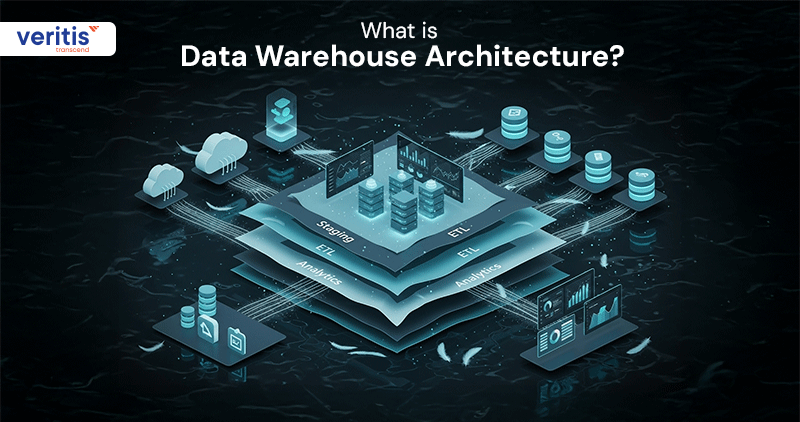
Every executive has experienced it: the long wait for answers while competitors move faster. Imagine your CFO requesting quarterly revenue projections, but the data is scattered across twenty disconnected systems. Instead of gaining quick clarity, days pass, opportunities slip, and your market position weakens. This is why data warehouse architecture has become the backbone of enterprise strategy. It provides a unified foundation that consolidates data, accelerates reporting, and empowers leaders to make timely, confident, and data driven decisions.
At its core, what is data warehouse architecture? It is the design blueprint that defines how an organization collects, transforms, and delivers data to decision makers. When implemented correctly, an enterprise data warehouse architecture becomes the single source of truth, ensuring that finance, operations, and marketing all work with the same reliable insights. Without it, executives risk steering the business with fragmented information, leading to inconsistent outcomes and missed growth opportunities.
At Veritis, we have witnessed how the exemplary architecture of data warehouse transforms decision making from reactive to proactive. For instance, a Fortune 500 retailer we supported reduced reporting time from 72 hours to just 30 minutes after implementing a modern data warehouse architecture. The breakthrough was not technology alone. It was applying a thoughtful data architecture strategy tailored to their business needs.
C-suite leaders must decide: Rely on outdated systems or embrace modern data architecture consulting services that deliver speed, accuracy, and competitive advantage. Whether exploring different types of data warehouse architecture, investing in data warehouse optimization, or building a holistic enterprise data architecture, the path forward is clear. The companies that modernize their data foundation are the ones that convert raw information into boardroom ready intelligence.
Schedule a Data Architecture Assessment
What is Data Warehouse Architecture?
Data warehouse architecture is the design framework that defines how an organization collects, stores, and delivers data for analysis and decision making. It consolidates information from multiple sources into a single, reliable system, enabling executives to access accurate insights when needed. A well structured architecture ensures consistency, scalability, and efficiency, making it a cornerstone of enterprise strategy.
Types of Data Warehouse Architectures
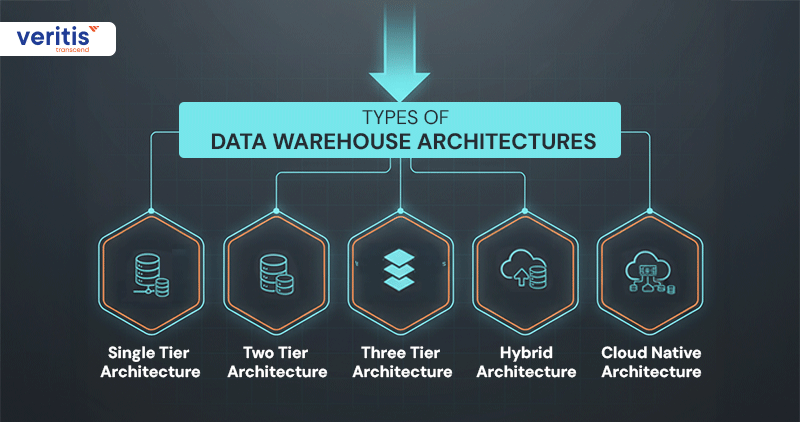
Selecting the right data warehouse architecture is one of the most important strategic decisions for any enterprise. The choice directly affects how effectively your organization can leverage data for competitive advantage. Different types of data warehouse architecture have emerged over the years, each with distinct benefits and limitations. A well defined data architecture strategy evaluates these options to identify the most suitable architecture for the data warehouse in your enterprise.
1) Single Tier Architecture
The single tier model is the most basic form of data warehouse architecture. Here, storage, processing, and reporting all reside in one tier. While simple and cost effective for organizations with limited data, it quickly creates bottlenecks as analytical and transactional processes compete for resources. For large enterprises, this approach rarely supports growth or data warehouse optimization at scale.
2) Two Tier Architecture
The two tier model introduces separation between data storage and analytics. Source data is centralized into a warehouse and then made available for reporting and visualization. This structure improves performance over single tier systems but struggles with scalability and high concurrency. Many organizations adopt it as a transitional stage before moving to a whole enterprise data warehouse architecture.
3) Three Tier Architecture
The three tier model is the most widely adopted and robust type of data warehouse architecture. It introduces a clear separation between data integration, data storage, and business intelligence. This layered design supports scalability, flexibility, and long term sustainability.
- Bottom tier: Data sources and staging
- Middle tier: Analytical engine (OLAP server)
- Top tier: Front end tools for visualization and reporting
For many enterprises, it has become the gold standard for building a modern data warehouse architecture. At Veritis, our Data Architecture Services specialize in designing and implementing such three tier systems, ensuring executives gain a reliable single source of truth.
4) Hybrid Architecture
In many enterprises, the future is hybrid. A hybrid data warehouse architecture blends on-premises systems with cloud based platforms, allowing organizations to maximize existing investments while exploring the agility of the cloud. This approach is particularly valuable for enterprises with strict compliance, security, or data residency requirements, and forms a critical part of a resilient enterprise data architecture.
5) Cloud Native Architecture
As cloud adoption accelerates, cloud data warehouse architecture has become a cornerstone of digital transformation. Built entirely in the cloud, it offers elasticity, real time analytics, and pay as you go pricing models.
For enterprises seeking to process big data and deliver instant insights, cloud native systems are the foundation of a truly modern data warehouse architecture. Partnering with modern data architecture consulting services enables executives to align cloud native systems with enterprise goals while ensuring performance and cost efficiency.
Useful Link: The Impact of Cloud Integration on Managed Data Services
Comparison of Data Warehouse Architectures
| Architecture Type | Key Advantages | Limitations | Business Impact |
| Single Tier | Simple setup, low cost, minimal infrastructure | Performance bottlenecks, poor scalability, and limited optimization | Works for small organizations but is not suited for enterprise growth |
| Two Tier | Improved performance over single tier, centralized storage, faster reporting | Limited scalability, struggles with high concurrency, transitional model | Suitable for mid size enterprises or as a stepping stone to enterprise systems |
| Three Tier | Clear separation of layers, scalable, flexible, easier maintenance, supports advanced analytics | Higher implementation complexity requires a robust data architecture strategy | Considered the gold standard for enterprise data warehouse architecture, ensures consistent insights across business units |
| Hybrid | Combines on-premises and cloud, leverages existing infrastructure, supports compliance and security needs | Integration challenges, governance complexity | Offers flexibility for enterprises in transition, supports long term data warehouse optimization |
| Cloud Native | Elastic scaling, pay as you go pricing, real time analytics, and a modern platform for big data | Dependence on a cloud provider requires strong cloud governance | The core of modern data warehouse architecture delivers agility and cost efficiency for data driven enterprises |
Data Warehouse Layers
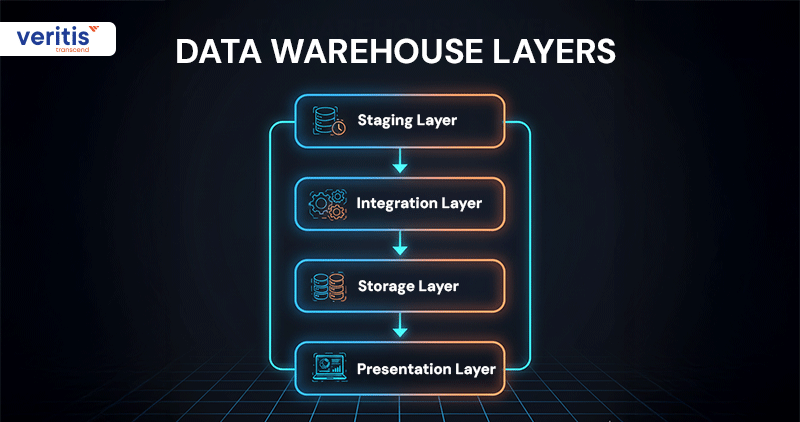
For executives, understanding data warehouse architecture is less about the technical jargon and more about how each layer contributes to faster, and more reliable decision making. A well designed enterprise data warehouse architecture is built on distinct layers, each with a specific role, working together as part of a resilient data warehouse system architecture. When aligned with a strong data architecture strategy, these layers transform fragmented information into boardroom ready intelligence.
1) Staging Layer
The staging layer is the entry point for all data warehouse components. Raw data from CRMs, ERPs, or even an operational data store (ODS) flows here. Minimal transformation happens at this stage; it is about securing the pipeline and ensuring junk does not pollute downstream systems.
In the discussion of data lake vs data warehouse, the staging layer provides a crucial safeguard for quality control. At Veritis, we utilize data warehouse automation tools to streamline ingestion, minimize manual effort, and expedite data warehouse optimization.
2) Integration Layer
The integration layer is where data harmony is achieved. Information from different formats and sources is standardized, reconciled, and unified into a consistent structure. This step is central to ensuring a centralized data warehouse that eliminates silos across business units. For executives, this means finance, operations, and marketing teams finally see the same version of truth. Our Data Architecture Services refine this layer to align with data warehouse best practices, ensuring seamless workflows within both hybrid data warehouse and cloud-based data warehousing environments.
3) Storage Layer
The storage layer is the most critical layer of the architecture of data warehouse. Here, cleansed data is organized into optimized structures such as star and snowflake schemas. In a three-tier data warehouse architecture, this layer powers analytics with speed and reliability. Modern designs leverage columnar storage to support real-time data warehousing and big data warehouse solutions. Veritis specializes in data warehouse performance tuning, ensuring storage is designed for both today’s workloads and tomorrow’s scale.
4) Presentation Layer
The presentation layer is where the business value becomes visible. Data is delivered through intuitive dashboards, self service analytics, and real time reporting. For executives, this is the layer that democratizes insight across the enterprise, ensuring that every decision maker can act with clarity. Our enterprise data architecture approach enhances this layer with advanced visualization, ensuring compliance with data warehouse governance, security in data warehouse, and executive grade delivery of intelligence.
Useful Link: How SaaS Business Intelligence is Revolutionizing Data Driven Decision Making
Data Warehouse Components
Beyond the logical layers, a data warehouse architecture comprises several key physical data warehouse components that work together to deliver analytical insights. Every component contributes directly to the system’s performance and reliability. Mastering data warehouse components is a crucial step in developing an effective enterprise data warehouse architecture that delivers business value.
- Central Database: This is the core of the data warehouse, a repository that stores all the integrated data. It is optimized for query performance and analysis.
- ETL (Extract, Transform, Load) Tools: These tools extract data from various sources, reshape it into a consistent, usable format, and move it into the data warehouse. This process is fundamental to ensuring data quality and consistency.
- Metadata: This is “data about data.” Metadata provides context for the data in the warehouse, including its source, transformations, and business definitions. It is a critical component for data warehouse governance.
- Access Tools: These are the applications that end users employ to interact with the data in the warehouse. They can range from simple query and reporting tools to sophisticated data mining and OLAP applications.
- Data Marts: These subsets of the data warehouse are optimized to support the unique requirements of specific departments. Data marts provide a more focused and accessible view of the data for specific user groups.
A comprehensive data architecture strategy will carefully select and integrate these data warehouse components to create a cohesive and high performing system. Veritis’s modern data architecture consulting services can help you in selecting the proper components for your specific requirements.
Data Warehouse Design Principles
A resilient enterprise data warehouse architecture is defined by principles that ensure scalability, trust, performance, and security. These are the foundations of a future ready data architecture strategy.
1) Scalability and Flexibility
- Why it matters: Growth in data and users is inevitable.
- Design priority: Architect for elastic scaling and adaptability to new sources.
- Executive impact: Future proof operations with a modern data warehouse architecture that grows with the enterprise.
2) Data Quality and Consistency
- Why it matters: Inconsistent data undermines decisions.
- Design priority: Embed cleansing, validation, and standardization.
- Executive impact: A single, trusted source of truth aligned to data warehouse governance.
3) Performance and Optimization
- Why it matters: Leaders need answers in real time, not days.
- Design priority: Build in data warehouse optimization and performance tuning (indexing, partitioning, materialized views).
- Executive impact: Instant access to intelligence for agile decision making.
4) Security and Governance
- Why it matters: Data is a critical enterprise asset.
- Design priority: Implement robust access controls, compliance safeguards, and breach prevention.
- Executive impact: Trust and confidence across the enterprise data architecture.
Benefits of Data Warehouse Architecture
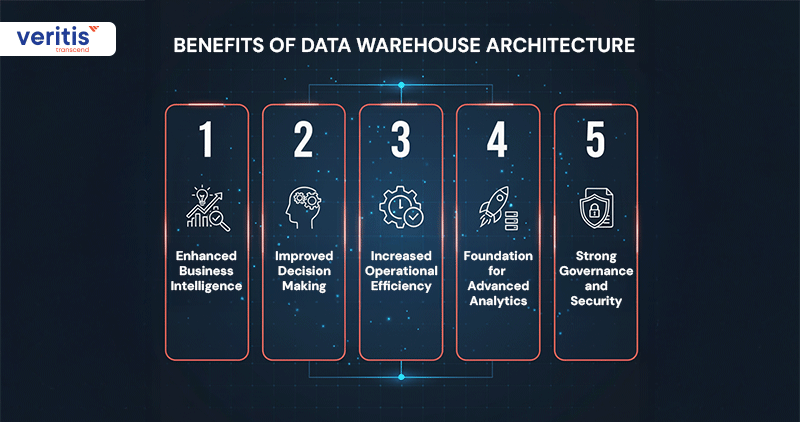
Investing in a robust data warehouse architecture is not a technology decision; it is a business transformation strategy. A well executed data architecture strategy creates measurable value across the enterprise, from boardroom intelligence to frontline efficiency.
1) Enhanced Business Intelligence
- What it means: A centralized and enterprise data warehouse architecture consolidates all data into a single version of truth.
- Business outcome: Executives gain sharper insights, identify emerging trends, and uncover opportunities hidden in siloed systems.
- Strategic driver: Modernizing with a modern data warehouse architecture ensures intelligence is accurate, timely, and actionable.
- Extra advantage: Consistent metrics across departments foster alignment, strengthening collaboration across the enterprise.
2) Improved Decision Making
- What it means: Clean, consistent, and governed data eliminates guesswork.
- Business outcome: Leaders at every level, from the C-suite to operational teams, make confident, data driven choices.
- Strategic driver: A resilient architecture of data warehouse strengthens enterprise agility and market responsiveness.
- Extra advantage: Decisions are accelerated with real-time data warehousing, ensuring competitive moves are made ahead of the market.
3) Increased Operational Efficiency
- What it means: Data warehouse optimization and automation reduce the manual effort of wrangling and reconciling data.
- Business outcome: Technical teams are freed to focus on strategic initiatives, while business users access insights instantly.
- Strategic driver: Efficiency gains compound over time, lowering costs and accelerating enterprise performance.
- Extra advantage: Integrating a hybrid data warehouse or cloud-based data warehousing approach further streamlines processes and reduces IT overhead.
4) Foundation for Advanced Analytics
- What it means: A modern data warehouse architecture creates the structured, historical, and trusted datasets required for AI and machine learning.
- Business outcome: Enterprises explore predictive modeling, personalized customer experiences, and new revenue opportunities.
- Strategic driver: A well governed enterprise data architecture is the launchpad for innovation and big data warehouse solutions.
- Extra advantage: Supports integration with external data sources and advanced data warehouse components, expanding analytics capabilities enterprise wide.
5) Strong Governance and Security
- What it means: Built in data warehouse governance and security in data warehouse design ensures compliance, protects sensitive information, and enforces access controls.
- Business outcome: Reduces regulatory risk, strengthens stakeholder trust, and safeguards enterprise reputation.
- Strategic driver: A secure and governed data warehouse system architecture underpins sustainable growth, particularly for industries handling sensitive financial, healthcare, or customer data.
- Extra advantage: Enhances audit readiness and streamlines regulatory reporting, turning compliance into a strategic enabler rather than a business burden.
Useful Link: Data Mining in Healthcare – IT Strategies for Transformative Results
Challenges for Data Warehouse Architecture
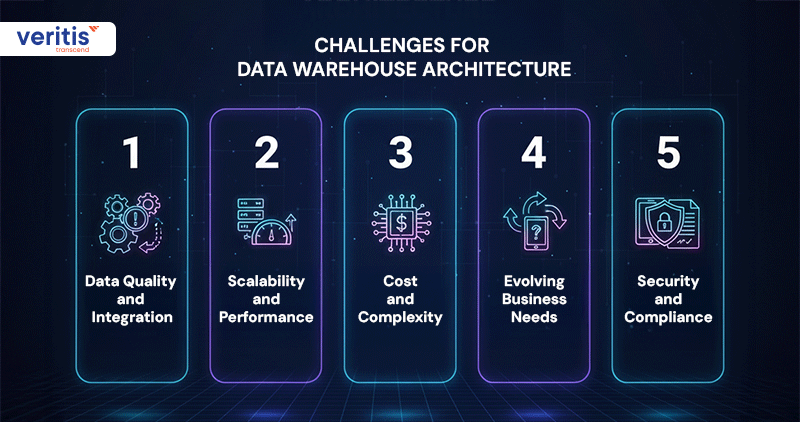
1) Data Quality and Integration
Challenge
Integrating data from multiple systems introduces inconsistent formats, definitions, and data quality, which weakens trust.
Veritis Solutions
- Implement automated ETL and ELT with data warehouse automation tools, data contracts, and reusable data warehouse components for consistent ingestion.
- Establish data warehouse governance with catalog, lineage, and stewardship to enforce definitions and PII controls.
- Unify sources across data lake vs data warehouse patterns using CDC, APIs, and an operational data store (ODS).
- Deliver a centralized data warehouse that becomes the single source of truth in your enterprise data warehouse architecture.
2) Scalability and Performance
Challenge
As data and users grow, queries slow and concurrency suffers. Without scale, analytics stalls.
Veritis Solutions
- Design a three-tier data warehouse architecture on a cloud data warehouse architecture with workload isolation and autoscaling.
- Apply data warehouse performance tuning: partitioning, clustering, indexing, materialized views, and caching.
- Enable real-time data warehousing with streaming and micro batch ingestion.
- Provide continuous data warehouse optimization and monitoring so executives get consistent speed at scale.
3) Cost and Complexity
Challenge
Traditional on-premises stacks are expensive to build and maintain, requiring specialized skills and heavy upfront investment.
Veritis Solutions
- Transition to cloud-based data warehousing or hybrid data warehouse with pay as you go pricing and elastic compute.
- Provide infrastructure as code templates and standardized data warehouse system architecture blueprints.
- Automate deployment, testing, and monitoring to reduce complexity and operating costs.
- Apply FinOps practices, proper sizing, and storage tiering to control cloud spend.
4) Evolving Business Needs
Challenge
Static designs cannot keep pace with the evolving needs of new data sources, metrics, and advanced analytics requirements.
Veritis Solutions
- Build modular enterprise data architecture with governed semantic layers and flexible data marts.
- Adopt metadata driven pipelines to onboard new sources and KPIs quickly.
- Enable advanced big data warehouse solutions such as AI and predictive analytics without costly rework.
- Align evolving roadmaps with business priorities through our Data Architecture Services and modern data architecture consulting services.
5) Security and Compliance
Challenge
As data volumes increase, so do the associated risks. Sensitive financial, healthcare, and customer information must be safeguarded against breaches and regulatory violations to ensure compliance.
Veritis Solutions
- Embed security in data warehouse design with role based access, encryption, and audit trails.
- Enforce compliance through automated monitoring aligned to GDPR, HIPAA, SOX, and industry standards.
- Apply data warehouse governance frameworks to strengthen accountability and transparency.
- Deliver enterprise data architecture built for trust, ensuring secure, compliant, and future ready analytics environments.
Best Practices for Data Architecture
A resilient enterprise data architecture is guided by proven practices that strike a balance between governance, agility, and innovation. Executives who adopt these best practices ensure their modern data warehouse architecture evolves into a long term strategic asset.
1) Align Architecture with Business Strategy
- Practice: Every design choice should map directly to business outcomes, not technical efficiency.
- Execution: Define clear business KPIs, then structure data warehouse system architecture to support them.
- Executive Value: Ensures ROI from data investments, keeps IT and the C-suite aligned.
2) Prioritize Data Quality and Governance
- Practice: Embed cleansing, validation, lineage, and stewardship from ingestion to presentation.
- Execution: Apply robust data warehouse governance frameworks and enforce consistency across departments.
- Executive Value: Builds trust in analytics, strengthens compliance, and ensures decisions are based on reliable information.
3) Build for Scalability and Flexibility
- Practice: Architect for elastic scaling, modularity, and integration of new sources.
- Execution: Use cloud data warehouse architecture, hybrid data warehouse, and modular design patterns.
- Executive Value: Future proofs the business, avoids costly reengineering, and accelerates adoption of new use cases.
4) Optimize for Performance Continuously
- Practice: Treat data warehouse optimization as an ongoing discipline.
- Execution: Apply data warehouse performance tuning techniques (partitioning, indexing, caching, workload isolation).
- Executive Value: Guarantees executives have real time or near real time intelligence for fast decisions.
5) Strengthen Security and Compliance
- Practice: Make security in data warehouse design non negotiable.
- Execution: Implement encryption, RBAC, audit trails, and align with GDPR, HIPAA, and SOX.
- Executive Value: Safeguards sensitive assets, protects brand reputation, and keeps regulators satisfied.
6) Enable Advanced Analytics and Innovation
- Practice: Design the architecture of data warehouse as a foundation for AI, ML, and predictive models.
- Execution: Integrate big data warehouse solutions, real-time data warehousing, and flexible APIs.
- Executive Value: Explores new revenue streams, sharper forecasting, and competitive advantage.
7) Automate for Efficiency and Agility
- Practice: Use data warehouse automation tools to simplify ingestion, testing, and monitoring.
- Execution: Apply metadata driven frameworks and reusable templates.
- Executive Value: Reduces manual workload, accelerates deployment, and lowers operational costs.
8) Invest in Continuous Skills and Partnerships
- Practice: Combine internal capability building with trusted external expertise.
- Execution: Leverage Data Architecture Services and modern data architecture consulting services for acceleration.
- Executive Value: Ensures your data architecture strategy stays current, innovative, and aligned with industry best practices.
Conclusion
A well designed data warehouse architecture is crucial for turning data into a competitive advantage. From consolidating information across the enterprise to enabling real-time data warehousing, it empowers smarter decisions, better governance, and scalable growth.
With the rise of cloud data warehouse architecture, even mid size organizations can achieve enterprise grade intelligence. At Veritis, our Data Architecture Services and modern data architecture consulting services help you design, optimize, and secure your warehouse so your data becomes the foundation for long term business success.